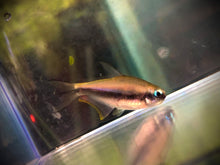Emperor Tetra (Nematobrycon palmeri)
Overview
The Emperor Tetra (Nematobrycon palmeri) is a stunning freshwater fish known for its vibrant colors and peaceful nature. Native to the slow-moving rivers and streams of Colombia, this tetra is a favorite among aquarists for its regal appearance and ease of care.
Product Details
- Scientific Name: Nematobrycon palmeri
- Common Name: Emperor Tetra
- Family: Characidae
- Origin: Colombia
Appearance
- Size: Up to 2 inches (5 cm)
- Color: Males boast a vibrant blue and purple sheen with a distinctive black stripe running from the nose to the tail, while females are generally less colorful with a more subdued hue.
- Body Shape: Slender and elongated with long, flowing fins.
Care Requirements
- Tank Size: Minimum 20 gallons
- Temperature: 73-81°F (23-27°C)
- pH: 6.0-7.5
- Water Hardness: 3-12 dGH
- Diet: Omnivorous – Flakes, small pellets, frozen, and live foods like brine shrimp and daphnia.
Tank Setup
- Substrate: Fine gravel or sand
- Plants: Dense vegetation with floating plants to diffuse light
- Decor: Driftwood, rocks, and leaf litter to mimic natural habitat
- Lighting: Moderate to low
- Filter: Gentle filtration to mimic their natural slow-moving waters
Tank Mates
- Compatibility:Peaceful community fish
- Good Tank Mates: Other tetras, rasboras, small barbs, Corydoras, and dwarf cichlids like Apistogramma
- Avoid: Large or aggressive fish, fin nippers, and predatory species
Behavior and Temperament
- Social Structure: Schooling fish – best kept in groups of 6 or more
- Temperament: Peaceful, generally non-aggressive
- Activity Level: Moderately active, often seen swimming at mid-levels of the tank
Breeding
- Breeding Setup: Separate breeding tank with fine-leaved plants for egg-laying
- Water Conditions: Slightly acidic, soft water
- Spawning: Males display to attract females; females lay eggs on plants
- Care of Fry: Remove adults post-spawning; fry can be fed infusoria and baby brine shrimp



